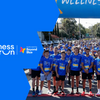Runners' Hydration Guide: Are You Getting Enough Water on Your Runs?
As runners, we understand the importance of fueling our bodies for optimal performance. We meticulously plan our training schedules, fine-tune our diets (okay, most of the time!), and select the perfect running gear. However, one crucial element that's often overlooked but just as vital is hydration.
How much water should you carry when you're running?
It's a question that can make the difference between a smooth, energized run and a dehydrated, sluggish struggle. You know the ones, early in the morning or late afternoon perhaps, a dry throat, a sluggish feel, one where you're struggling to hit the pace or distance you usually can do.
In this article, we'll dive into the science of staying hydrated during your runs and provide you with practical tips to determine the ideal amount of water to carry. Whether you're a seasoned marathoner or just starting your running journey, understanding your hydration needs is key to reaching your full potential and ensuring every step you take is a step in the right direction.
The Factors Affecting Hydration
Environmental Conditions

Environmental conditions, such as weather and altitude, significantly impact your hydration needs. Hot and humid weather causes increased sweating and fluid loss, while cold weather can mask thirst cues, potentially leading to dehydration. When planning your run, consider the climate and altitude to adjust your hydration strategy accordingly.
Running Duration and Intensity

The duration and intensity of your run affect how much you should hydrate. Longer and more intense runs make you sweat more, leading to increased fluid and electrolyte loss. To maintain performance and prevent dehydration, adjust your hydration plan based on your run's length and intensity.
We'll take a look at how the distance of your run is a crucial factor in determining how much water you should be taking with your in your hydration vest.
Individual Variations

Hey, we're all different. Hydration needs vary among individuals due to factors like genetics, body size, and sweat rates. Many will try to tell you there's a hard and fast calculation for how much water you need. Sure, these can be a good guide, but they shouldn't be considered the holy grail. Some people are heavy sweaters, while others retain fluids more effectively. Recognise these differences and experiment to find the right hydration balance that suits your unique needs and preferences.
As you continue your running journey, you're going to learn a lot about your body. When it should be pushed, when to taper back, and how much water your body needs to function at optimal performance.
Say it with me: we're all different.
Me? I drink water like it's nobody's business. I feel like I need it. I drink 3L+ daily to feel like I can not only perform athletically at a high level, but for concentration, health and wellbeing.
It goes without saying, but water is essential for the proper functioning of your body. Healthy and lubricated joints, spinal cord protection, blood circulation, tissue protection, healthy bowel movement and temperature control. Whatever bodily process you can think of, water is probably a key ingredient.
Calculating Your Water Needs
The 8x8 Rule: Fact or Fiction?
You may have heard of the "8x8 rule," which suggests drinking eight 8-ounce glasses of water (around 240ml) daily for optimal hydration. While it's a simple guideline to remember, it's not necessarily one-size-fits-all. The 8x8 rule is a basic recommendation, but your hydration needs depend on various factors, such as your activity level, body size, and environmental conditions. It's essential to listen to your body and drink when you're thirsty, rather than rigidly adhering to a specific quantity. So, while the 8x8 rule can be a starting point for daily hydration, it's crucial to adapt your water intake to your individual requirements.
Perhaps you need more, maybe less. The 8x8 rule can be a good starting point for measuring how much you actually need by self-evaluating daily and weekly on your energy levels, muscle fatigue, concentration and general health.
Sweat Rate and Loss
Understanding your sweat rate is a valuable tool for customising your hydration strategy. To calculate your sweat rate, weigh yourself before and after a run, taking into account the fluids consumed. The difference in weight represents your sweat loss. For every pound lost during exercise, it's generally recommended to consume 16-24 ounces of fluid to rehydrate effectively. Monitoring your sweat rate in various conditions and over different distances can help you fine-tune your hydration plan, ensuring you replace the fluids and electrolytes lost during exercise accurately.
Creating a Personalised Hydration Plan
A personalised hydration plan is the key to staying optimally hydrated during your runs. Start by considering factors like your body size, sweat rate, and the weather conditions you typically run in. It's also crucial to experiment during training to find the right balance between water and electrolytes. Carry the appropriate gear based on your hydration needs, whether it's a handheld bottle, a hydration belt, or a vest. Tailor your intake to the duration and intensity of your runs, aiming to sip fluids regularly rather than chugging large amounts at once. By creating a personalized hydration plan, you can enhance your running experience, minimize the risk of dehydration, and ensure your body gets the fluids it needs to perform at its best.
How Much Water Should You Carry Based On The Distance Of The Run?
If you've read this far, you know we're not big on hard and fast universal calculations because every single person is different.
But, we know that it helps to have a starting guide. So based on the distance of your run we've put together a starting point for you to test and optimise your own hydration plan around it.
How Much To Drink On Short Runs (5-10K)
When you're gearing up for a short run, such as a 5K or 10K'er, it's easy to think that hydration may not be a top priority.
After all, these distances are relatively brief, and the temptation to carry water may be low. However, even short runs can lead to dehydration if you're not careful. The key here is to strike a balance. For most runners, hydrating before the run is usually sufficient for a 5K or 10K, as long as you're well-hydrated in general. In a 5k run that might take you 20-30 minutes, the difference in having a few sips of water at the 3km mark or not will not make a huge different to your overall performance. It's a short enough distance that you should be able to go without carrying water with you.
During the run, it's essential to listen to your body. If it's a scorching day or you feel thirsty, consider taking sips of water at designated points along your route.
A handheld water bottle may also be a practical choice. The bottom line is that for shorter runs, you don't need to carry a lot of water, if any, but being mindful of the environmental conditions and your hydration is still important to ensure a successful and comfortable run.
How Much To Drink On Mid-Distance Runs (10-25K)
As you progress to mid-distance runs like half marathons, the need for a more structured hydration plan becomes evident. During a half marathon, which typically covers 21(ish)km'ers, your body will expend a significant amount of energy and fluids.
It's crucial to start the race well-hydrated and strongly consider carrying water or electrolyte drinks with you. For longer races, aid stations may be available along the course, but it's wise to bring a handheld bottle, hydration belt or hydration vest with you to ensure you have access to fluids when needed.
If you're training by yourself, or in scenarios where hydration stations are not available, it's highly recommended to carry a form of hydration vest with you - you'd rather have it than not.
Sip small amounts of water at regular intervals to maintain optimal hydration without overloading your stomach. Finding the right balance is essential for mid-distance runs, as it can help you maintain energy and performance throughout the race.
How Much To Drink On Long-Distance Runs (25k+)
When it comes to marathons, ultra marathons and just longer runs in general, hydration takes on a whole new level of importance. For these grueling runs, a comprehensive hydration strategy is vital.
Start by hydrating well in the days, weeks and even months leading up to the race, as dehydration can have a significant impact on your performance. During the race, you will need to carry a hydration vest or pack with a substantial water reservoir (water bladder). In addition to water, consider electrolyte drinks and energy gels to replace lost nutrients. Aid stations will be available, but the distance between them may require additional hydration. To avoid hitting the wall due to dehydration, make it a priority to take in fluids and electrolytes regularly. Long-distance races demand a meticulous and adaptable hydration approach to ensure you stay strong and resilient until the finish line.
For these type of runs, it is recommended to carry a 2L water bladder plus a couple of backup soft flasks to keep you hydrated throughout the run.
Remember to always sip slow, try not to take in too much water in a short-space of time.
Selecting The Right Hydration Gear
Handheld Water Bottles
Handheld water bottles can be a popular choice among runners for their simplicity and ease of use. Some runners love them, some can't stand them.
These bottles typically come with a strap or handle that allows you to hold them comfortably during your run (depending on who you ask!). They're a solid option for shorter distances, but shouldn't be considered for any type of longer run.
Handheld bottles are available in various sizes, so you can choose one that suits your hydration needs. Some even come with pockets for storing essentials like energy gels. Whether you're a beginner or a seasoned runner, a handheld water bottle can be a practical and convenient addition to your running gear, helping you stay hydrated without much fuss.
Handheld Water Bottles cost around $30-70 and one option is the 'Quick Squeeze' from Nathan priced at $59.99.
Hydration Belts and Packs

Hydration belts and packs are designed for runners who want to carry more fluids and have additional storage space for essentials like gels, keys, or a smartphone.
These belts and packs typically have multiple water bottles or reservoirs/bladders attached to a waist belt or light vest-like pack. They distribute the weight evenly, so you don't feel burdened by the added load. For longer runs, especially in warm conditions, a hydration belt or pack can provide you with the hydration and storage you need to stay comfortable and prepared throughout your run. They come in various styles, with options to fit different body shapes and preferences.
Hydration belts/pack can cost between $50 and $150. A decent option would be a 'CamelBak Flash' coming in at $98.90.
Also consider the Original Runly Vest which has capacity to fit your phone + a small soft flask for hydration, priced at $79.
Hydration Vests

Hydration vests are a popular choice among long-distance and trail runners. These vests come with built-in water reservoirs, offering a more significant water-carrying capacity than belts or handheld bottles. The vest design evenly distributes the weight across your torso, making it comfortable for extended periods of wear. In addition to the hydration reservoir, hydration vests typically feature multiple pockets and storage compartments, making them suitable for carrying a range of essentials like extra layers of clothing, nutrition, and personal items.
If you're serious about your running, this is an essential piece of gear.
Hydration vests are versatile and well-suited for ultramarathons, long trail runs, or any distance where you need to carry a decent amount of water and gear. Choosing the right hydration gear ultimately depends on your running preferences, the distance you plan to cover, and your storage needs, so pick the option that best fits your requirements.
Hydration Vests can vary from $150-400+. Two great options are the Runly R700 Hydration Vest for $239 and the Ultimate Direction Adventure Vest for $289.95.
A Final Reminder on the Importance of Monitoring Your Water Intake:
As we conclude this exploration of running and hydration, it's crucial to leave you with a final reminder: monitoring your water intake should be a continuous and intuitive process. Listen to your body's cues and adapt to the changing conditions you face during your runs. The key to success lies in finding the perfect balance between dehydration and overhydration, between taking too little and too much.
Every run is a learning experience, an opportunity to fine-tune your hydration plan and discover what works best for you. So, keep those water bottles, belts, or vests handy, and remember that staying adequately hydrated is not just a necessity but a vital part of your running lifestyle. With the right strategy, you'll be well-prepared to conquer any distance that lies ahead.





